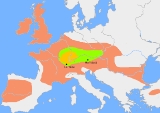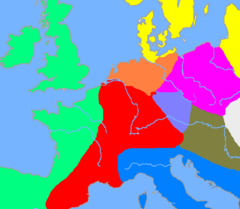
Pre-Celtic
Encyclopedia
The term pre-Celtic refers to the period in the prehistory of Central and Western Europe postdating the emergence of Proto-Celtic and predating the expansion of the Celts, or Celtic culture, in the course of the earlier Iron Age (9th to 6th centuries BC). The area involved is that of the maximum extent of Celtic languages in about the mid 1st century BC. The extent to which "Celtic" language, culture and genetics coincided and interacted during this period remains very uncertain and controversial.
, the hypothetical Proto-Italo-Celtic
dialects, Belgian
, "Old European
") on one hand, and non-Indo-European and pre-Indo-European
languages (variously hypothesized to include Basque
, Etruscan
and Rhaetic
) on the other.
Recent work by Foster and Toth, Gray and Atkinson, Rexova, Frynta and Zrzavy suggests that the Proto-Celtic language
branched from the Indo-European tree between 8,000 to 10,000 years ago. Note, though, that Proto-Indo-European itself is usually believed to have been spoken only about 6,000 years ago, so significant differences of opinion exist; the Anatolian hypothesis
is often associated with older divergence points.
 In both continental Europe and the British Isles, the pre-Celtic populations are likely to have been the originators of the megalith
In both continental Europe and the British Isles, the pre-Celtic populations are likely to have been the originators of the megalith
cultures (the Atlantic Bronze Age
). In the later Celtic areas there are many archaeological cultures.
In Ireland the Book of Invasions gives a pseudo-history for a number of incoming peoples.
Languages
For continental Europe, pre-Celtic languages of the European Bronze Age may be taken to include other Indo-European dialects (Illyrian, possibly LusitanianLusitanian language
Lusitanian was a paleohispanic language that apparently belonged to the Indo-European family. Its relationship to the Celtic languages of the Iberian Peninsula, either as a member, a cousin , or as a different branch of Indo-European, is debated. It is known from only five inscriptions, dated from...
, the hypothetical Proto-Italo-Celtic
Italo-Celtic
In historical linguistics, Italo-Celtic is a grouping of the Italic and Celtic branches of the Indo-European language family on the basis of features shared by these two branches and no others. These are usually considered to be innovations, which are likely to have developed after the breakup of...
dialects, Belgian
Belgian language
Belgian is a hypothetical extinct Indo-European language. It was described by the Ghentian linguist Maurits Gysseling - who himself attributed the term to Prof. Dr. S.J. De Laet - as an Indo-European language that was spoken distinct from Celtic in late prehistory, in certain parts of what has...
, "Old European
Old European hydronymy
Old European is the term used by Hans Krahe for the language of the oldest reconstructed stratum of European hydronymy in Central and Western Europe...
") on one hand, and non-Indo-European and pre-Indo-European
Indo-European languages
The Indo-European languages are a family of several hundred related languages and dialects, including most major current languages of Europe, the Iranian plateau, and South Asia and also historically predominant in Anatolia...
languages (variously hypothesized to include Basque
Basque language
Basque is the ancestral language of the Basque people, who inhabit the Basque Country, a region spanning an area in northeastern Spain and southwestern France. It is spoken by 25.7% of Basques in all territories...
, Etruscan
Etruscan language
The Etruscan language was spoken and written by the Etruscan civilization, in what is present-day Italy, in the ancient region of Etruria and in parts of Lombardy, Veneto, and Emilia-Romagna...
and Rhaetic
Raetic language
Raetic is an extinct language spoken in the ancient region of Raetia in the Eastern Alps in pre-Roman and Roman times. It is documented by a limited number of short inscriptions in two variants of the Etruscan alphabet...
) on the other.
Recent work by Foster and Toth, Gray and Atkinson, Rexova, Frynta and Zrzavy suggests that the Proto-Celtic language
Proto-Celtic language
The Proto-Celtic language, also called Common Celtic, is the reconstructed ancestor language of all the known Celtic languages. Its lexis can be confidently reconstructed on the basis of the comparative method of historical linguistics...
branched from the Indo-European tree between 8,000 to 10,000 years ago. Note, though, that Proto-Indo-European itself is usually believed to have been spoken only about 6,000 years ago, so significant differences of opinion exist; the Anatolian hypothesis
Anatolian hypothesis
The Anatolian hypothesis is also called Renfrew's Neolithic Discontinuity Theory ; it proposes that the dispersal of Proto-Indo-Europeans originated in Neolithic Anatolia...
is often associated with older divergence points.
Archaeology

Megalith
A megalith is a large stone that has been used to construct a structure or monument, either alone or together with other stones. Megalithic describes structures made of such large stones, utilizing an interlocking system without the use of mortar or cement.The word 'megalith' comes from the Ancient...
cultures (the Atlantic Bronze Age
Atlantic Bronze Age
The Atlantic Bronze Age is a cultural complex of the Bronze Age period of approximately 1300–700 BC that includes different cultures in Portugal, Andalusia, Galicia, Armorica and the British Isles.-Trade:...
). In the later Celtic areas there are many archaeological cultures.
History
When the Celts are first recorded about 600 BC they are already widespread across Iberia, Gaul and Central Europe. Various associations with archaeological cultures have been assumed but without much justification. The homeland of the Celts is very controversial.In Ireland the Book of Invasions gives a pseudo-history for a number of incoming peoples.
See also
- Neolithic EuropeNeolithic EuropeNeolithic Europe refers to a prehistoric period in which Neolithic technology was present in Europe. This corresponds roughly to a time between 7000 BC and c. 1700 BC...
- Old European culture
- Bronze Age EuropeBronze Age EuropeThe European Bronze Age is characterized by bronze artifacts and the use of bronze implements. The regional Bronze Age succeeds the Neolithic, it starts with the Aegean Bronze Age 3200 BC...
- Old European hydronymyOld European hydronymyOld European is the term used by Hans Krahe for the language of the oldest reconstructed stratum of European hydronymy in Central and Western Europe...
- Pre-Germanic
- Vasconic languagesVasconic languagesThe Vasconic substratum theory is a proposal that many western European languages contain remnants of an old language family of Vasconic languages, of which Basque is the only surviving member. The proposal was made by the German linguist Theo Vennemann, but has been rejected by other linguists...
- Atlantic (Semitic) languagesAtlantic (semitic) languagesThe Atlantic languages of Semitic or "Semitidic" origin are a disputed concept in historical linguistics put forward by Theo Vennemann...
- Pre-Roman peoples of the Iberian PeninsulaPre-Roman peoples of the Iberian PeninsulaThis is a list of the Pre-Roman peoples of the Iberian peninsula .-Non-Indo-European:*Aquitanians**Aquitani**Autrigones - some consider them Celtic .**Caristii - some consider them Celtic ....
- Prehistoric BritainPrehistoric BritainFor the purposes of this article, Prehistoric Britain is that period of time between the first arrival of humans on the land mass now known as Great Britain and the start of recorded British history...
- Bronze Age BritainBronze Age BritainBronze Age Britain refers to the period of British history that spanned from c. 2,500 until c. 800 BC. Lasting for approximately 1700 years, it was preceded by the era of Neolithic Britain and was in turn followed by the era of Iron Age Britain...
- Prehistoric IrelandPrehistoric IrelandThe prehistory of Ireland has been pieced together from archaeological and genetic evidence; it begins with the first evidence of Mesolithic hunter-gatherers settling in Ireland around 7000 BC and finishes with the start of the historical record, around AD 400. The prehistoric period covers the...
- Paleolithic Continuity TheoryPaleolithic Continuity TheoryThe Paleolithic Continuity Theory , since 2010 relabelled as the Paleolithic Continuity Paradigm , is a hypothesis suggesting that the Proto-Indo-European language can be traced back to the Upper Paleolithic, several millennia earlier than the Chalcolithic or at the most Neolithic estimates in other...
- Italo-CelticItalo-CelticIn historical linguistics, Italo-Celtic is a grouping of the Italic and Celtic branches of the Indo-European language family on the basis of features shared by these two branches and no others. These are usually considered to be innovations, which are likely to have developed after the breakup of...
- Goidelic substrate hypothesis

